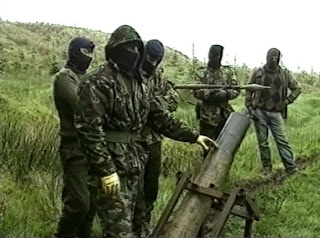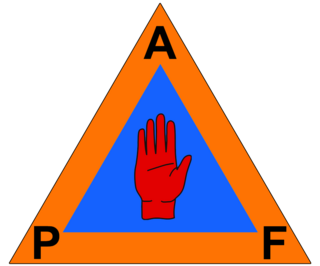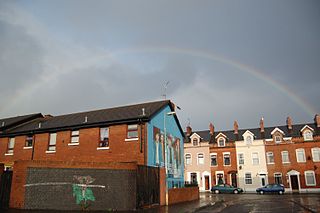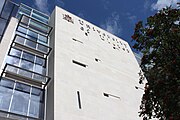
The Troubles were an ethno-nationalist conflict in Northern Ireland that lasted for about 30 years from the late 1960s to 1998. Also known internationally as the Northern Ireland conflict, it is sometimes described as an "irregular war" or "low-level war". The conflict began in the late 1960s and is usually deemed to have ended with the Good Friday Agreement of 1998. Although the Troubles mostly took place in Northern Ireland, at times violence spilled over into parts of the Republic of Ireland, England, and mainland Europe.
Pádraig Oliver McKearney was a Provisional Irish Republican Army (IRA) paramilitary. He was killed during a British Army ambush at Loughgall, County Armagh in May 1987, aged 32. He had 15 years of service as an IRA Volunteer when he was shot dead at Loughgall, making him one of the most experienced IRA Volunteers ever killed by British forces.

From 1969 until 1997, the Provisional Irish Republican Army (IRA) conducted an armed paramilitary campaign primarily in Northern Ireland and England, aimed at ending British rule in Northern Ireland in order to create a united Ireland.

Silverbridge is a small village in the townland of Legmoylin in County Armagh, Northern Ireland. It is within the Newry and Mourne District Council area. In the 2011 Census it had a recorded population of 112. The local GAA club is Silverbridge Harps GFC, which plays football at Senior level in county competitions. The area was historically called Belanargit.
The Troubles were a period of conflict in Northern Ireland involving republican and loyalist paramilitaries, the British security forces, and civil rights groups. They are usually dated from the late 1960s through to the Good Friday Agreement of 1998. However, sporadic violence continued after this point. Those that continued violence past this point are referred to as "dissident republicans and loyalists". The Troubles, internationally known as the Northern Ireland conflict, claimed roughly 3500 lives.

Divis Tower is a 20-floor, 200-foot (61 m) tall tower in Belfast, Northern Ireland. It is located in Divis Street, which is the lower section of the Falls Road. It is currently the fifteenth-tallest building in Belfast.
The South Armagh Republican Action Force shortened simply to the Republican Action Force for a small number of attacks in Belfast was an Irish republican paramilitary group that was active from September 1975 to April 1977 during the Troubles in Northern Ireland. Its area of activity was mainly the southern part of County Armagh. According to writers such as Ed Moloney and Richard English, it was a cover name used by some members of the Provisional IRA South Armagh Brigade. The journalist Jack Holland, alleged that members of the Irish National Liberation Army (INLA) were also involved in the group. During the same time that the South Armagh Republican Action Force was active the INLA carried out at least one sectarian attack that killed Protestant civilians using the covername "Armagh People's Republican Army". According to Malcolm Sutton's database at CAIN, the South Armagh Republican Action Force was responsible for 24 deaths during the conflict, all of whom were classified as civilians.

The Protestant Action Force (PAF) was a front group used by Ulster loyalist paramilitaries in Northern Ireland when claiming responsibility for a number of attacks during the Troubles. First used in 1974, attacks by individuals claiming to be members of the PAF killed at least 41 Catholic civilians. The PAF was most commonly used by members of the Ulster Volunteer Force (UVF). All of the attacks claimed by the PAF in Armagh and Tyrone counties from 1974 to 1976 have been linked to the Glenanne gang, which was a group consisting of members of the UVF Mid-Ulster Brigade along with rogue Ulster Defence Regiment (UDR) soldiers and Royal Ulster Constabulary (RUC) police officers. A six-year period of no attacks claimed by the PAF ended in 1982; during the 1980s, the PAF claimed 15 attacks in the Belfast area and two in County Armagh. UDR soldiers were convicted of two attacks in Armagh. The PAF claimed its last attacks in the early 1990s, all of which were in north Armagh and were alleged to involve members of the security forces.
Robert Martin McBirney QC, known as Martin McBirney, was a magistrate and politician from Northern Ireland who was assassinated.
The 1994 Shankill Road killings took place on 16 June 1994 when the Irish National Liberation Army (INLA) shot dead three Ulster Volunteer Force (UVF) members – high-ranking member of the UVF Belfast Brigade staff Trevor King and two other UVF members, Colin Craig and David Hamilton – on the Shankill Road in Belfast, close to the UVF headquarters. The following day, the UVF launched two retaliatory attacks. In the first, UVF members shot dead a Catholic civilian taxi driver in Carrickfergus. In the second, they shot dead two Protestant civilians in Newtownabbey, who they believed were Catholics. The Loughinisland massacre, two days later, is believed to have been a further retaliation.
The Rose & Crown Bar bombing was a bomb attack carried out against a Catholic-owned pub in Belfast. The attack was carried out by the loyalist paramilitary group the Ulster Volunteer Force (UVF) just less than two weeks before the start of the Ulster Workers' Council strike of May 1974 which brought down the Sunningdale power sharing agreement and just 15 days before the UVF carried out the Dublin and Monaghan bombings which killed 34 and injured 300 people, the highest casualty rate in a single day during The Troubles in either Ireland or Britain.
On 11 August 1970, two Royal Ulster Constabulary (RUC) officers were killed by a booby-trap bomb planted under a car by the Provisional Irish Republican Army (IRA) near Crossmaglen, in County Armagh, Northern Ireland. They were the first RUC officers to be killed by republicans during the Troubles and the first security forces to be killed in South Armagh, an IRA stronghold for much of the conflict.
On 17 June 1974 the Provisional IRA bombed the British Houses of Parliament causing extensive damage and injuring eleven people.
On 2 October 1975, the loyalist paramilitary group the Ulster Volunteer Force (UVF) carried out a wave of shootings and bombings across Northern Ireland. Six of the attacks left 12 people dead and around 45 people injured. There was also an attack in a small village in County Down called Killyleagh. There were five attacks in and around Belfast which left people dead. A bomb which exploded in Coleraine left four UVF members dead. There were also several other smaller bombs planted around Northern Ireland but other than causing damage they did not kill or injure anyone.
The Belturbet bombing occurred on 28 December 1972 when a car bomb planted by Loyalist paramilitaries exploded in the main street in the border town of Belturbet in County Cavan in the Republic of Ireland. The bomb killed two teenagers Geraldine O'Reilly (15) and Patrick Stanley (16). Nobody claimed responsibility for the bombing but security services believe the Ulster Volunteer Force (UVF) carried out the attack. The attack happened just a few weeks after two people were killed and 127 injured when two car bombs exploded in the centre of Dublin, Republic of Ireland on 1 December 1972. On the same day as the Belturbet bombing, two other bombs exploded in border counties, the first in Clones, County Monaghan which injured two people and the second in Pettigo in County Donegal which caused injury to a single female victim. The three bombs all exploded within 49 minutes of each other, all three bombings were believed to be part of a co-ordinated attack attributed to a single organization.

In the late hours of 3 February and the early hours of 4 February 1973, six men, all of whom were Catholics, were shot and killed in the New Lodge area of north Belfast:

The Central Bar bombing was a bomb attack on a pub in the town of Gilford near Portadown in County Down in Northern Ireland on 31 December 1975. The attack was carried out by members of the Irish National Liberation Army (INLA) using the covername "People's Republican Army" although contemporary reports also said the "Armagh unit" of the "People's Republican Army" had claimed responsibility. Three Protestant civilians were killed in the bombing.
The following is a timeline of actions during The Troubles which took place in the Republic of Ireland between 1969 and 1998. It includes Ulster Volunteer Force bombings such as the Dublin and Monaghan bombings in May 1974, and other Loyalist bombings carried out in the 1970s, 80s & 90s, the last of which was in 1997. These attacks killed dozens of people and injured hundreds more. Also actions carried out by Irish Republicans including bombings, prison escapes, kidnappings, and gun battles between the Gardaí (police) and the Irish Defence Forces against Republican gunmen from the Irish National Liberation Army, the Provisional Irish Republican Army, and a socialist-revolutionary group, Saor Éire. These attacks killed a number of civilians, police, soldiers, and Republican paramilitaries.
The Charlemont pub attacks were co-ordinated militant Loyalist paramilitary attacks on two pubs in the small village of Charlemont, County Armagh, Northern Ireland, carried out by the Ulster Volunteer Force (UVF) on the 15 May 1976. The attacks have been attributed to the Glenanne gang which was a coalition of right-wing Loyalist paramilitaries and subversive members inside the Royal Ulster Constabulary (RUC), the Ulster Defense Regiment (UDR) and the British Army.

The RTÉ Studio bombing was a 1969 bomb attack carried out by the Ulster Loyalist paramilitary group the Ulster Volunteer Force (UVF) in Dublin, Ireland. It was the first Loyalist bombing in the Republic of Ireland during the Troubles.









